A sinkhole in Madagascar recently revealed its watery secrets. The underwater cave, located in one of the island's national parks, contained troves of fossils. The fossil creatures included many different species, including lemurs, hippos, a crocodile, and the islands largest predatory cat. Some of the fossils are of animals that went extinct a few thousand years ago, while others are of animals still living on the island today. The fossil graveyard could shed light on the unprecedented extinction rate that plagues the creatures of Madagascar. [Read the full story on the lemur graveyard] (Photo credit:Phillip Lehman and Pietro Donaggio-Bitner)
Hot tip
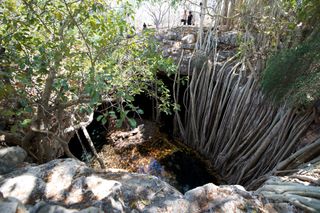
Experienced cave diver Phillip Lehman was exploring the underwater caves in the Dominican Republic, where he lives, when he received a tip about a cave in Tsimanampetsotsa National Park that was teeming with fossils. The park is located in an arid region of Madagascar. Lehman contacted one of the researchers he works with, Alfred Rosenberger, a phyiscal anthropologist at Brooklyn College, City University of New York, and the team decided to explore the sinkhole. Here a view into the cave from above.
Swiss-cheese landscape
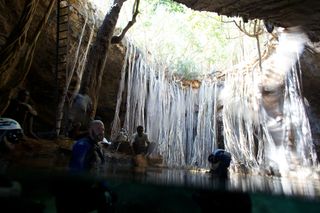
The landscape at Tsimanampetsotsa National Park is made of limestone that is eaten away by water, leaving a Swiss-cheese like landscape full of holes, caves and tunnels. Here, a view the water in Aven cave. Aven means sinkhole in French.
Transition Zone
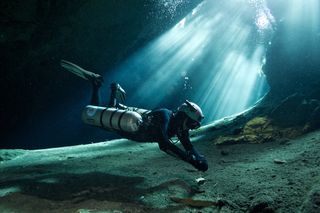
The divers descended about 82 feet (25 m) into the water. Though the entry into the cave is vertical, the floor of the cave slopes downward at one point. In the transition zone where the light from the surface disappears, the team found a trove of stunning fossils.
Sign up for the Live Science daily newsletter now
Get the world’s most fascinating discoveries delivered straight to your inbox.
Primate graveyard

Though the team found fossils from myriad species, many belonged to primates, such as this exquisitely preserved skull from the extinct lemur Pachylemur insignis. It's not clear when exactly these fossils were deposited, but based on when some of the species found in the cave went extinct, the oldest fossils may be a few thousand years old.
Extinct crocodile
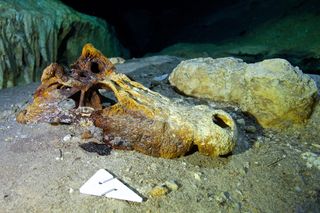
The team also found the fossil skeleton of an extinct crocodile, called Voay robustus. Scientists still don't understand how the animals wound up in the cave, though most likely they didn't go willingly. Instead, it's likely that a series of storms, typhoons or flash floods swept the animals into the cave over the years. The one animal that may have been lurking in the cave intentionally was the crocodile, Rosenberger said.
Giant fosa
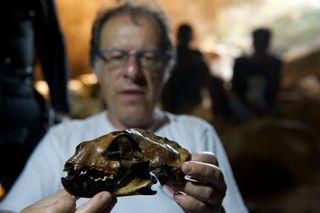
Here, Rosenberger holds the jaw of a Giant Fosa, which was freshly taken from the water. This extinct carnivore, also known as Cryptoprocta spelea, looks a bit like a mongoose and is related to an animal that currently lives on the island. Madagascar is losing animals to extinction at a breakneck pace.
Extinct pig
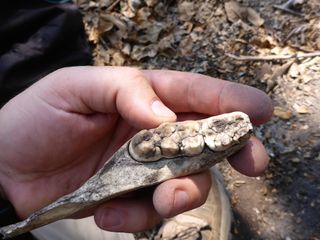
Here, the lower molars and partial jaw of an African bushpig known as Potamochoerus, which was found near the Aven sinkhole but is now extinct on Madagascar. Because there is an overlap in the time period when some of the species went extinct and when humans soon after colonized the island, roughly 3,000-years-ago, researchers could begin to understand what's causing the islands catastrophic extinction and whether humans have anything to do with it.
Pristine condition

Many of the fossils were in pristine condition, thanks to the cold, still waters where little live lives. Here, the teeth and jaw of an extinct Pachylemur insignis are still in excellent condition. While this fossil is on its own here, many of the bones are still in association, meaning that the skull and the body of one animal are found in the same region. It's usually much more common for fossils to be broken up and disarticulated, Rosenberger said.
Follow Tia Ghose on Twitter and Google+. Follow LiveScience @livescience, Facebook & Google+

Tia is the managing editor and was previously a senior writer for Live Science. Her work has appeared in Scientific American, Wired.com and other outlets. She holds a master's degree in bioengineering from the University of Washington, a graduate certificate in science writing from UC Santa Cruz and a bachelor's degree in mechanical engineering from the University of Texas at Austin. Tia was part of a team at the Milwaukee Journal Sentinel that published the Empty Cradles series on preterm births, which won multiple awards, including the 2012 Casey Medal for Meritorious Journalism.
